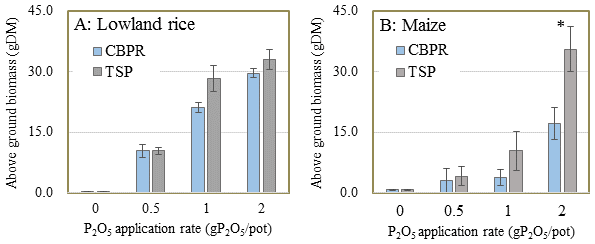Calcination improves solubility of low-grade African phosphate rock and application of calcined products is highly effective on crop cultivation
Description
The utilization of local African phosphate rock (PR) can be considered a key factor in solving hunger and poverty in Africa through improvement of crop productivity. It is well known that large amounts of phosphate deposits exist in Sub-Saharan Africa, with reserve estimates of around 100 million tons of P2O5 in Burkina Faso. However, this PR resource has not been fully utilized because of limited solubility. Numerous studies have attempted to utilize these low-grade PRs with various crops, and results have indicated that the direct application of PR exhibits substantial variation in effectiveness, reflecting the influence of various factors such as PR solubility, soil properties, and the types of crops.
For the abovementioned reason, an effective solubilization method for these PR is highly required. Sulfuric acid addition is the most popular solubilization method, and sulfuric acid is also used for partial acidulation of PR. However, in the case of low-grade African PR, the partial acidulation method is potentially problematic because of the low solubilization rate and the accumulation of residual free sulfuric acid.
We attempted to solubilize low-grade PR produced in Burkina Faso using Akiyama’s calcination method, which was previously developed for high silicate PRs. Results showed that PR calcination between 900-1000 °C with composition of 25-30% Na2O sourced by sodium carbonate (Na2CO3) solubilized PR effectively. Phosphorus (P) solubility in 2% citric acid solution was leached about 100%, and P solubility in water was increased to 28%.
Results also clarified that higher composition of Na2O increases solubility in 2% citric acid and in water. On the other hand, adding larger amounts of sodium carbonate consequently decreases total P2O5 content in calcined PR.
Furthermore, the effects of calcined Burkina Faso PR (CBPR) application on rice and maize growth were evaluated through a pot experiment. CBPR calcined at 950 °C with 30% Na2O was investigated for this pot experiment. Lowland rice and maize were cultivated for 56 days under four levels of P2O5 application, i.e., 0.0, 0.5, 1.0, and 2.0 g P2O5 /pot. Nitrogen and potassium were applied using 1g N and 1 g K2O per pot. CBPR application for lowland rice indicated comparable effect with Triple Super Phosphate (TSP) application at application rates of up to 2 g P2O5/pot. In the case of maize, CBPR application yielded about 40% of TSP application.
Crop productivity improvement in Africa would be highly expected through provision of affordable fertilizer using low-grade African PR. Calcination technology is likely to be applicable not only for Burkina Faso PR but also for all other low-grade PRs in Africa.
Figure, table
-
Table 1. Total P2O5 content and solubility for citric acid and water of calcined PR
Na20, Na25, Na30 indicate Na2O treatment compositions at 20%, 25%, and 30%, respectively. Different alphabets denote significant difference (p <0.05) among calcination temperatures using Tukey’s multiple comparison (n=3). *Calcined PR of Na30 at 950 °C was used for the subsequent pot experiment. -
Fig. 1. Effect of applying calcined PR and TSP on aboveground biomass yield of lowland rice (A) and maize (B)
CBPR: Calcined Burkina Faso phosphate rock, TSP: Triple super phosphate. Error bars are standard errors (n=3). Asterisk in the figure denotes significant difference (p < 0.05) between yields of CBPR and TSP using Student’s t test.
- Affiliation
-
Japan International Research Center for Agricultural Sciences Crop, Livestock and Environment Division
- Program name
- Term of research
-
FY2016(FY2014~FY2015)
- Responsible researcher
-
Nakamura Satoshi ( Crop, Livestock and Environment Division )
ORCID ID0000-0002-0952-5618KAKEN Researcher No.: 00749921Nagumo Fujio ( Crop, Livestock and Environment Division )
KAKEN Researcher No.: 20399372Fukuda Monrawee ( Crop, Livestock and Environment Division )
Toriyama Kazunobu ( Crop, Livestock and Environment Division )
KAKEN Researcher No.: 30355557Imai Toshio ( Taiheiyo Cement Corporation )
- ほか
- Publication, etc.
-
Nakamura, et al. (2015) Japanese Journal of Soil Science and Plant Nutrition. 86 (6):534-538
Nakamura, et al. (2016) Japanese Journal of Soil Science and Plant Nutrition. 87 (5):338-347
- Japanese PDF
-
A4 325.58 KB
A3 249.84 KB
- English PDF
-
A4 539.79 KB
A3 517.98 KB
- Poster PDF
-
Poster 412.41 KB

